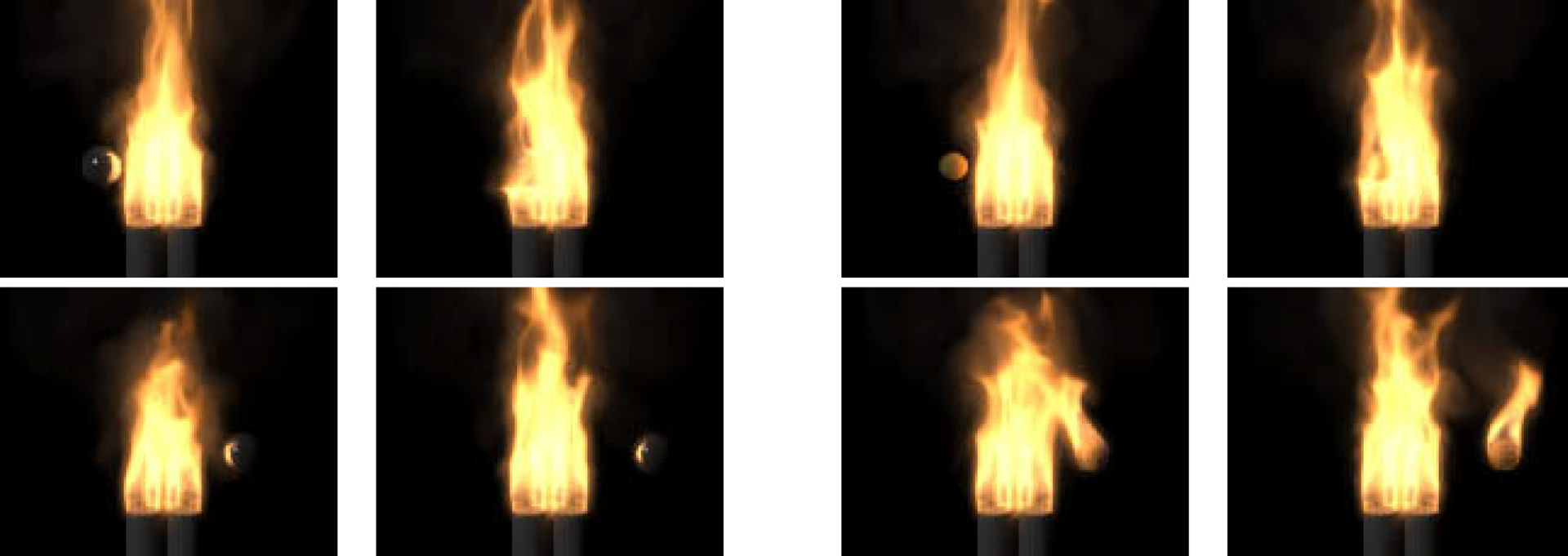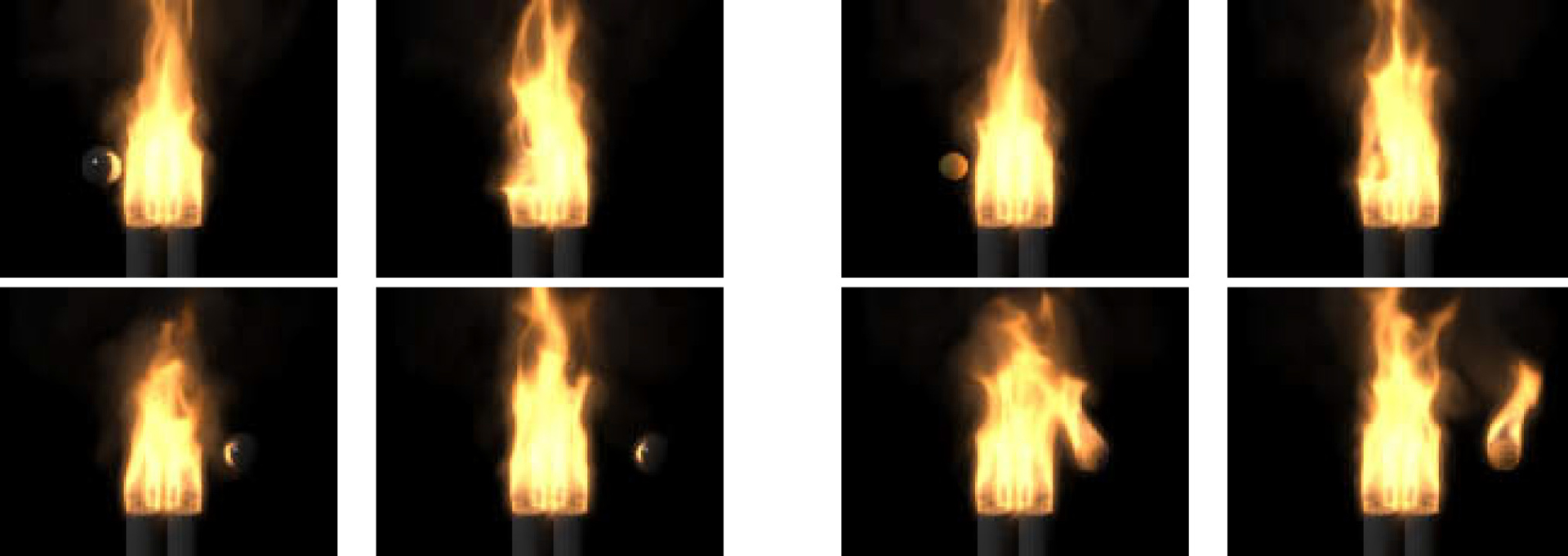“Physically based modeling and animation of fire”
Conference:
Type(s):
Title:
- Physically based modeling and animation of fire
Presenter(s)/Author(s):
Abstract:
We present a physically based method for modeling and animating fire. Our method is suitable for both smooth (laminar) and turbulent flames, and it can be used to animate the burning of either solid or gas fuels. We use the incompressible Navier-Stokes equations to independently model both vaporized fuel and hot gaseous products. We develop a physically based model for the expansion that takes place when a vaporized fuel reacts to form hot gaseous products, and a related model for the similar expansion that takes place when a solid fuel is vaporized into a gaseous state. The hot gaseous products, smoke and soot rise under the influence of buoyancy and are rendered using a blackbody radiation model. We also model and render the blue core that results from radicals in the chemical reaction zone where fuel is converted into products. Our method allows the fire and smoke to interact with objects, and flammable objects can catch on fire.
References:
1. BUKOWSKI, R., AND SEQUIN, C. 1997. Interactive Simulation of Fire in Virtual Building Environments. In Proceedings of SIGGRAPH 1997, ACM Press / ACM SIGGRAPH, Computer Graphics Proceedings, Annual Conference Series, ACM, 35-44. Google Scholar
2. CHIBA, N., MURAOKA, K., TAKAHASHI, H., AND MIURA, M. 1994. Two dimensional Visual Simulation of Flames, Smoke and the Spread of Fire. The Journal of Visualization and Computer Animation 5, 37-53.Google Scholar
3. DEVLIN, K., AND CHALMERS, A. 2001. Realistic visualisation of the pompeii frescoes. In AFRIGRAPH 2001, ACM SIGGRAPH, A. Chalmers and V. Lalioti, Eds., 43-47. Google Scholar
4. DURAND, F., AND DORSEY, J. 2000. Interactive Tone Mapping. In Proceedings of Eleventh Eurographics Workshop on rendering, 219-230. Google Scholar
5. FAIRCHILD, M. 1998. Color Appearance Models. Addison Wesley Longman, Inc.Google Scholar
6. FEDKIW, R., ASLAM, T., MERRIMAN, B., AND OSHER, S. 1999. A Non-oscillatory Eulerian Approach to Interfaces in Multimaterial Flows (The Ghost Fluid Method). J. Comput. Phys. 152, 457. Google Scholar
7. FEDKIW, R., STAM, J., AND JENSEN, H. W. 2001. Visual Simulation of Smoke. In Proceedings of SIGGRAPH 2001, ACM Press / ACM SIGGRAPH, E. Fiume, Ed., Computer Graphics Proceedings, Annual Conference Series, ACM, 15-22. Google Scholar
8. FOSTER, N., AND FEDKIW, R. 2001. Practical Animation of Liquids. In Proceedings of SIGGRAPH 2001, ACM Press / ACM SIGGRAPH, Computer Graphics Proceedings, Annual Conference Series, ACM, 23-30. Google Scholar
9. FOSTER, N., AND METAXAS, D. 1997. Modeling the Motion of a Hot, Turbulent Gas. In Proceedings of SIGGRAPH 1997, ACM Press / ACM SIGGRAPH, Computer Graphics Proceedings, Annual Conference Series, ACM, 181-188. Google Scholar
10. GROSSHANDLER, W. 1995. RADCAL: A Narrow-band Model for Radiation Calculations in Combustion Environment. NIST Technical Note 1402 (April).Google Scholar
11. HENYEY, L., AND GREENSTEIN, J. 1941. Diffuse radiation in the galaxy. Astrophysics Journal 93, 70-83.Google Scholar
12. INAKAGE, M. 1989. A Simple Model of Flames. In Proceedings of Computer Graphics International 89, Springer-Verlag, 71-81. Google Scholar
13. MARKSTEIN, G. H. 1964. Nonsteady Flame Propagation. Pergamon, Oxford.Google Scholar
14. MAZARAK, O., MARTINS, C., AND AMANATIDES, J. 1999. Animating Exploding Objects. In Proceedings of Graphics Interface 1999, 211-218. Google Scholar
15. MUSGRAVE, F. K. 1997. Great Balls of Fire. In SIGGRAPH 97 Animation Sketches, Visual Procedings, ACM SIGGRAPH, 259-268.Google Scholar
16. NEFF, M., AND FIUME, E. 1999. A Visual Model for Blast Waves and Fracture. In Proceedings of Graphics Interface 1999, 193-202. Google Scholar
17. NGUYEN, D., FEDKIW, R., AND KANG, M. 2001. A Boundary Condition Capturing Method for Incompressible Flame Discontinuities. J. Comput. Phys. 172, 71-98. Google Scholar
18. O’BRIEN, J. F., AND HODGINS, J. K. 1999. Graphical Modeling and Animation of Brittle Fracture. In Proceedings of SIGGRAPH 1999, ACM Press / ACM SIGGRAPH, Computer Graphics Proceedings, Annual Conference Series, ACM, 137-146. Google Scholar
19. OSHER, S., AND SETHIAN, J. A. 1988. Fronts Propagating with Curvature Dependent Speed: Algorithms Based on Hamilton-Jacobi Formualtions. J. Comput. Phys. 79, 12. Google Scholar
20. PATTANAIK, S., FERWERDA, J. A., FAICHILD, M. D., AND GREENBERG, D. P. 1998. A Multiscale Model of Adaptation and Spatial Vision for Realistic Image Display. In Proceedings of SIGGRAPH 1998, ACM Press / ACM SIGGRAPH, Computer Graphics Proceedings, Annual Conference Series, ACM, 287-298. Google Scholar
21. PERRY, C., AND PICARD, R. 1994. Synthesizing Flames and their Spread. SIGGRAPH 94 Technical Sketches Notes (July).Google Scholar
22. RUSHMEIER, H. E., HAMINS, A., AND CHOI, M. 1995. Volume Rendering of Pool Fire Data. IEEE Computer Graphics and Applications 15, 4, 62-67. Google Scholar
23. RUSHMEIER, H. 1994. Rendering Participating Media: Problems and Solutions from Application Areas. In Proceedings of the 5th Eurographics Workshop on Rendering, 35-56.Google Scholar
24. SETHIAN, J. 1996. A Fast Marching Level Set Method for Monotonically Advancing Fronts. Proc. Nat. Acad. Sci. 93, 1591-1595.Google Scholar
25. SIEGEL, R., AND HOWELL, J. 1981. Thermal Radiation Heat Transfer. Hemisphere Publishing Corp., Washington, DC.Google Scholar
26. STAM, J., AND FIUME, E. 1995. Depicting Fire and Other Gaseous Phenomena Using Diffusion Process. In Proceedings of SIGGRAPH 1995, ACM Press / ACM SIGGRAPH, Computer Graphics Proceedings, Annual Conference Series, ACM, 129-136. Google Scholar
27. STAM, J. 1999. Stable Fluids. In SIGGRAPH 99 Conference Proceedings, Annual Conference Series, ACM Press / ACM SIGGRAPH, Computer Graphics Proceedings, Annual Conference Series, ACM, 121-128. Google Scholar
28. STANIFORTH, A., AND COTE, J. 1991. Semi-Lagrangian Integration Schemes for Atmospheric Models: A Review. Monthly Weather Review 119, 2206-2223.Google Scholar
29. STEINHOFF, J., AND UNDERHILL, D. 1994. Modification of the Euler Equations for “Vorticity Confinement”: Application to the Computation of Interacting Vortex Rings. Physics of Fluids 6, 8, 2738-2744.Google Scholar
30. TSITSIKLIS, J. 1995. Efficient Algorithms for Globally Optimal Trajectories. IEEE Transactions on Automatic Control 40, 1528-1538.Google Scholar
31. TURNS, S. R. 1996. An Introduction to Combustion. McGraw-Hill, Inc.Google Scholar
32. YNGVE, G. D., O’BRIEN, J. F., AND HODGINS, J. K. 2000. Animating Explosions. In Proceedings of SIGGRAPH 2000, ACM Press / ACM SIGGRAPH, Computer Graphics Proceedings, Annual Conference Series, ACM, 29-36. Google Scholar






